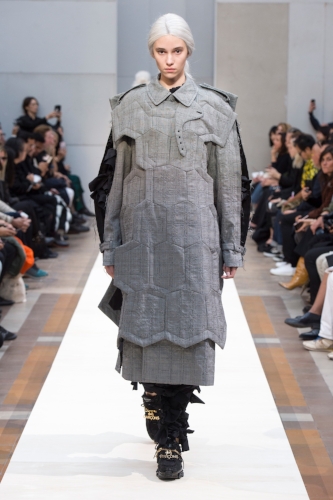Rei Kawakubo Presents Stately Comme Des Garçons Ceremony
By Taraneh Azar, Runway Correspondent
Photos courtesy of Vogue Runway
Comme Des Garçons presented their SS2019 Ready to Wear collection in a regal and ceremonial Paris Fashion Week proceeding.
Rei Kawakubo, most noted for her ability to convey pure emotion through her sculptural, awe-inspiring silhouettes, continued her tradition of beautifully orchestrated presentations that challenge what is known about femininity, culture, and balance. Announced by the designer’s husband Adrian Joffe, this 2019 “Mini Show” presents “a profoundly internal approach . . . about what’s deep inside,” according to Kawakubo. Thus, the presentation explored both Kawakubo’s deep emotions and the female condition through her garments rich with imagery and symbolism.
The presentation showcased a variety of sculpture-based trench coats, beautiful floor-sweeping gowns, and flowing linen-based garments. The collection took up many of Kawakubo’s most familiar shapes and cuts, yet complexified them with bulging sculptural lumps and extensions protruding from the models. They inched down the aisle in a ceremonial, highly-stylized proceeding, recalling her era-defining 1997 Ready to Wear collection.
Although Comme Des Garçons is mostly known for its diffusion line “Play”, the presentation proves Kawakubo’s brand is so much more than just a red heart with eyes plastered on Converse Chuck Taylor All Stars. The presentation conveys what Comme Des Garçons is truly about as a brand and culturally influencing force–artfully powerful symbolism through deeply intricate sculptural, garment-based design.
Some of the most dystopian looks featured restrictive shoulder-padded blazer tops that flowed straight into sheer mesh dresses, revealing silver chains wrapped underneath the garment and around the models’ bodies. Polka-dot patterns invoked the works of Dada and surrealist artist Yayoi Kusama. News-print fabrics alluded to global shifts in the media, perhaps tipping a hat to the #MeToo movement with the recurring restricted, feminine imagery. The pregnant, bulging bellies juxtaposed with the hidden chains drew parallels between the female condition and the stifling nature of gender roles and expected motherhood. As Kawakubo has no children herself, one can infer that sense of restriction comes from her own experience as a non-mother in a world that expects, if not encourages, women to reproduce.
The collection conveyed the refined and stately facade of the models through stiff blazer-collars, structured jackets with shoulder pads and restrictive cuts resembling straight-jackets. The garments worked to express a sentiment of balance between reflection and restriction. When you consider Kawakubo’s self-reflective statement for the show, the symbolism in her forms suggests a mindset of self-reflection, hyper-awareness, and criticism.
Taken as a whole, the collection reads as fashion as political and social commentary on the expectations society has for women. The ceremonial presentation seemingly maps a bizarre and anxiety-ridden world where the women are mute and physically restricted–a concept which certainly is not far off from the state of social and cultural commentary of this past week. The SS 2019 presentation is sure to set the tone for cultural metamorphosis as the artful collection, deep with symbolism, brings to light internalized gendered conditioning. Many have chosen to accept these gender-based expectations, but for those who have not, Kawakubo presents a platform and voice for resistance.








